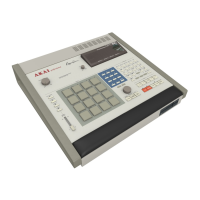Section 3: Recording sequences 77
3.17 Recording Midi System Exclusive data
The MPC60 has the capability to record patch library data or any other Midi
System Exclusive messages directly into tracks. To do this, simply send the
System Exclusive message to the MPC60 while in RECORD or OVERDUB
modes, or while in STEP EDIT mode, and it will be recorded into the active
track, just like any other midi data. The only limitation is that the message
must be less than 1000 bytes. If an attempt is made to record a message
which is larger than this, the entire message will be rejected. This will easily
accomodate single voice patch data dumps from any synthesizer, but is not
large enough for many voice bank data dumps (large files containing an
entire bank of single voice data dumps).
One way of using this feature is to insert a blank bar at the beginning of your
sequence and record the voice data dumps for each track into that first bar.
When the sequence is played from the start, each external synthesizer will
immediately receive the voice data in the first bar and is then ready to play
the sequence's note data starting in the second bar.
There is one problem with playing System Exclusive messages from
sequences: there is no standard method for identifying the midi channel
number within the message, and therefore the MPC60 cannot assign the
output midi channel over which the message will be sent. This means, for
example, that a System Exclusive message sent over midi channel 3 while
recording into the MPC60 will always be played out of the MPC60 on midi
channel 3, regardless of the track's output midi channel. To overcome this
problem, you must send the System Exclusive message on the desired midi
channel while recording it into the MPC60. Most synthesizers allow you to
select the transmit channel. However, the Yamaha DX-7 (original model)
always transmits on midi channel 1.
There is a way to change the midi channel of a System Exclusive message
while it is in the MPC60- by using STEP EDIT. The midi channel is
assigned to a single byte within the message and the Step Edit function
allows you to change the contents of any byte within the message. If you
know which byte a particular manufacturer uses for the channel number, you
can change the contents of that byte to the desired midi channel number.
For example, the Yamaha DX-7 System Exclusive messages contain the midi
channel in byte number 3, so whatever number you put into byte number 3
of the message will be the new output midi channel number. To learn more
about editing in step edit mode, read section 4.4: "The STEP EDIT key".

